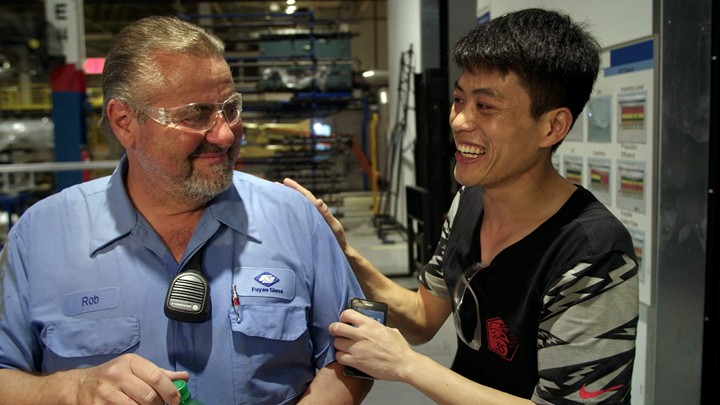American Factory
Directors/ Julia Reichert, Steven Bognar
Watched on Netflix
Rating 4/5
American Factory is both a straightforward chronicle of the fall, rise, and near fall again of a Dayton, Ohio manufacturing company, and a subtly scathing indictment of the future of working class labor in the U.S. It’s hard to watch this film and not want to scream, wail, or simply weep at the decomposed remains of the American Dream.
An astonishing level of access is what makes the documentary a fascinating, consistently engrossing film. Several scenes will have you silently asking, “How did the filmmakers manage to get that?” These moments, scattered throughout, are a testament to the tenacity and patience of the directors, Julia Reichert and Steven Bognar, and they reveal the cultural gulf that lies at the heart of the film.
Reichert and Bognar were there in 2009 when a General Motors plant shuttered its doors in the wake of the 2008 recession, putting thousands out of work. A few years later a Chinese billionaire saw an opportunity and re-fashioned the location into a factory making windshields, hiring several of the previous employees who, now desperate for jobs, were willing to work for a third of their previous pay. The factory, called Fuyao, is at first a source of renewed hope and optimism for the workers and a charming experiment in cross-cultural relationship building. But things began to sour fairly quickly.
The Chinese owners at first work in tandem with their American counterparts, but they have a difficult time adjusting to the employees’ expectations of an 8-hour day, a 40-hour work week, lunch breaks, and a culture of factory life based on craftmanship and brotherhood rather than quotas, speed, and sacrifice. A few hundred young Chinese workers are shipped in to instill efficiency and robotic precision in the slower and–it must be said–fatter American crew, but this only heightens tensions. Eventually, the American workers begin to organize, calling for union representation, which is anathema to the Fuyao owner who built his fortune on the backs of Communist unions, where fealty to the company trumps individual rights. He tells the American floor bosses that if they unionize he will close the factory.
American Factory’s complex chronology is made brilliantly clear by the filmmakers’ rigorous approach and unfiltered intimacy with many of the key players, including the Chinese owner, a man who actually commissioned the film. This allows the directors (and a young Chinese pair of filmmakers they hired) to get inside footage of meetings, inspection tours, and company junkets, in which the Chinese speak unguardedly about the American work ethic (“they are lazy” and “they like to be flattered”) and–in one rather terrifying scene–about how robots will allow them to eliminate several human workers by the end of the month.
These scenes are revelatory, but they also contain a layer of surprising empathy. The Chinese bosses and the employees are not soulless automatons. They are portrayed as real people with families left behind in China; children and spouses they may see once a year. They live 4 or 5 to an apartment, and they are conditioned to work without complaining. They also want to understand their American colleagues rather than merely exploit them. It’s rare to see a documentary these days that tries to grapple with emotional, political, and cultural content and not wrap it all up in a tidy, force-fed package to fidgety audiences.
The sheer abundance of conflicting, roiling material is responsible for the one drawback of the film. Few of the individual stories feel fleshed out or explored with enough depth. Several narrative strands are left dangling. Even as the film winds up, you feel there is so much more to be said; so many stories to tell. That is not necessarily a bad thing for any film. With Trump’s ruinous trade war in full swing, there may even be a sequel waiting to be made. By the end of American Factory however one thing is clear: all of the workers, Chinese and American alike, are at the mercy of a capitalist system in which survival–not riches, not dreams, not even a viable paycheck–is the only reward for waking up in the morning.

